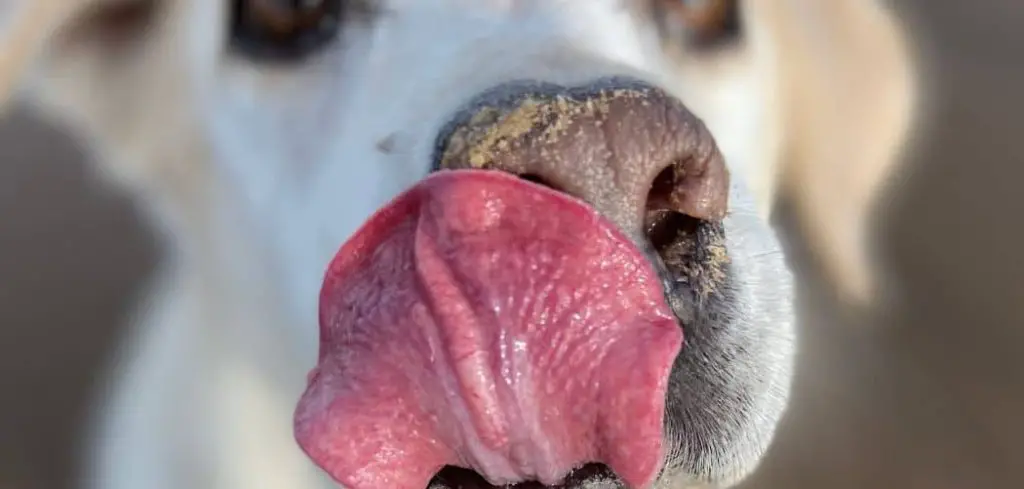Seeing your dog pant with their tongue hanging out can be alarming, especially if it happens frequently or without any apparent reason.
Panting with the tongue out may indicate normal cooling behavior, or potential health concerns.
We outline the common causes of panting with the tongue out in dogs, what you can do at home, and when to seek veterinary help.
Dog Panting and Tongue Out — Why It Happens
Dog panting with the tongue out is a normal cooling mechanism, but when it seems excessive or unusual, it may suggest overheating, dehydration, or respiratory strain. Dogs with long tongues or flat faces (like pugs and bulldogs) may pant this way more often.
However, if it comes with drooling, weakness, or collapse, it could indicate heatstroke or another urgent condition.

Dog Panting and Tongue Out: Common Causes
Heat and Overheating
Dogs often pant with their tongue out to regulate body temperature. Unlike humans, dogs rely on panting rather than sweating to cool down.
Hot environments, excessive sun exposure, or heavy bedding can trigger this behavior, especially during summer nights or after exercise.
Watch for other signs such as drooling, restlessness, reddened gums, or a rapid heartbeat.
Providing a cool environment, access to water, and ventilation helps your dog maintain a safe body temperature while preventing heat-related stress.
Read more: Dog Panting and Purple Tongue (What it means)
Excitement or Physical Activity
Panting with the tongue out can also be a normal response to excitement or recent activity. Dogs often exhibit this behavior after playing, running, or greeting their owners.
You may notice wagging tails, bright eyes, and an eager demeanor alongside panting. This type of panting is usually temporary and resolves once the dog rests and recovers from physical exertion.
Pain or Discomfort
Dogs experiencing pain may pant with their tongue out intermittently. Pain can stem from injuries, joint issues, arthritis, or internal discomfort. Panting serves as a response to stress or discomfort and may increase when lying down or shifting positions.
Other signs can include whining, reluctance to move, changes in appetite, or altered posture. Veterinary evaluation is crucial for identifying the underlying cause and providing appropriate pain relief.
Heart and Respiratory Conditions
Heart disease or respiratory disorders can lead to panting with the tongue out. Dogs with congestive heart failure, heart murmurs, or lung problems may have difficulty breathing and pant more frequently, sometimes displaying their tongue prominently as they try to take in more oxygen.
Watch for coughing, exercise intolerance, rapid breathing, or fainting. Early veterinary assessment and treatment help prevent serious complications.
Anxiety or Stress
Stress and anxiety can cause panting accompanied by the tongue sticking out. Separation anxiety, fear of loud noises, or unfamiliar environments can trigger intermittent panting, often worsened during nighttime or stressful situations.
Signs may include pacing, trembling, whining, or clinging behavior. Creating a calm environment, using pheromone diffusers, or engaging in positive reinforcement training can reduce anxiety-induced panting.
Fever or Infection
Fever and infections may cause dogs to pant with their tongue out. Elevated body temperature prompts panting as a cooling mechanism.
Infections such as respiratory illnesses, urinary tract infections, or systemic illnesses can also trigger this behavior.
Additional symptoms may include lethargy, reduced appetite, nasal discharge, or vomiting. Veterinary diagnosis ensures timely treatment and prevents worsening of the condition.
Oral or Dental Issues
Dental pain or oral discomfort can make a dog pant with their tongue out. Issues like tooth infections, gum disease, or oral sores can cause discomfort, prompting the dog to keep their mouth open or tongue protruding.
Other signs include drooling, difficulty eating, bad breath, or pawing at the mouth. Regular dental care and veterinary evaluation are essential for maintaining oral health and alleviating pain.
Medications or Hormonal Imbalances
Certain medications or hormonal disorders may contribute to panting with the tongue out.
Dogs taking medications for pain, heart disease, or anxiety may experience changes in breathing patterns. Hormonal conditions such as Cushing’s disease or thyroid imbalances can also influence respiratory and stress responses.
Signs include increased thirst, urination, weight changes, or coat alterations. Professional assessment ensures proper treatment while minimizing side effects.
What to Do If Your Dog Is Panting and Tongue Out
Ensure your dog has a cool, comfortable place to rest with easy access to fresh water. Monitor when panting occurs, noting time, duration, and accompanying behaviors, which can help your veterinarian identify patterns.
Maintain a consistent daily routine to reduce anxiety and provide opportunities for physical activity to release pent-up energy. Gentle exercise, calming routines, and environmental enrichment can prevent stress-related panting.
Check for any oral discomfort or dental issues by observing your dog’s eating habits and mouth health. If panting seems linked to pain or discomfort, schedule a veterinary appointment for assessment.
If panting persists despite these measures, particularly alongside other concerning signs, seek veterinary guidance to rule out medical conditions such as heart, respiratory, or hormonal disorders.
When to Call or Visit Your Vet
Seek veterinary attention immediately if your dog exhibits:
Persistent or labored panting with tongue out
Weakness, fainting, or disorientation
Bluish or pale gums, or rapid heartbeat
Vomiting, diarrhea, or refusal to eat
Signs of pain or sudden distress
Suspected heatstroke or ingestion of toxins
Prompt veterinary evaluation ensures that serious health issues are detected and treated early.
Read more: Dog Tongue Out and Not Eating (Here’s why)
Key Takeaway
Panting with the tongue out is often a normal cooling behavior or response to excitement, but it can also indicate pain, anxiety, infections, oral issues, or cardiovascular problems.
Monitoring your dog’s environment, behavior, and health, alongside regular veterinary checkups, helps ensure that panting remains safe and normal.
By identifying triggers and addressing underlying causes, you can help your dog stay comfortable and healthy.
